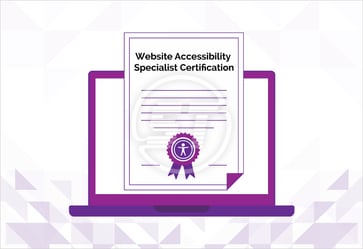If accessing digital information, filling out forms, or simply navigating a website is an uphill battle for individuals with disabilities, such websites or applications need to update their accessibility level on priority. Because accessibility challenges give tough time to users with disabilities and increase their distance from digital information.
To recognize this very issue, Illinois took a significant step forward with the Illinois Information Technology Accessibility Act (IITAA)—a law aimed at ensuring that everyone, regardless of ability, can access and use state-operated digital services.
So, what exactly is the IITAA, and why is it so important? Let’s dive in!
Illinois Information Technology Accessibility Act (IITAA) – its background!
The IITAA was enacted in 2008 to ensure that state agencies and public institutions in Illinois create and maintain accessible digital content and technology. This law mandates that websites, software, and other digital tools used by these entities must be usable by individuals with disabilities, including those with visual, hearing, motor, and cognitive impairments.
It aligns with widely accepted accessibility standards, such as:
- The Web Content Accessibility Guidelines (WCAG) – A global benchmark for website accessibility.
- Section 508 of the Rehabilitation Act - A federal law requiring electronic and information technology to be accessible to people with disabilities.
The IITAA is pivotal for government and all other organizations - Reasons!
The digital world is expanding rapidly, and nearly everything—from applying for jobs to paying bills—is done online. But for many individuals with disabilities, poorly designed websites and digital tools create significant barriers. The IITAA ensures:
- Equal access – Everyone including people with disabilities can access public services and information without obstacles.
- Legal compliance – The regulation ensures that agencies vanish risks of potential lawsuits and penalties for non-compliance.
- Enhanced user experience – Accessibility improvements benefit not just those with disabilities but everyone, including older adults and people using mobile devices.
Who needs to follow the IITAA?
The IITAA applies to:
- State government agencies
- Public universities and colleges
- Any organization developing digital resources for these institutions.
If a website, software, or app is created for these groups, it must meet IITAA’s accessibility standards.
Implementation of IITAA – A set process!
Step 1: Establishing accessibility standards
Before implementing accessibility improvement, the state needed clear and measurable standards. The IITAA Committee, a group of experts in accessibility, technology, and policy, established these standards by aligning them with WCAG 2.1 (minimum), Section 508, and other international standards.
And now when there is set standards for government and private entities, they ought to adhere to them. These standards ensure that:
Digital content must be easy to see, hear, and understand (Perceivable).
Users must be able to navigate and interact using keyboards, screen readers, and voice commands (Operable).
Information should be clear and user-friendly (Understandable).
Content should be compatible with current and future assistive technologies (Robust).
Step 2: Implementation by State Agencies
Once the accessibility standards are in place, state agencies and public institutions must integrate them into their technology development and procurement processes.
This includes:
- When creating new websites or applications, agencies must ensure they meet IITAA accessibility requirements.
- Any existing website, software, or document must be modified to comply with IITAA standards.
- When purchasing third-party software or services, agencies must require vendors to meet IITAA standards.
- Employees responsible for digital content receive training on accessibility best practices.
Step 3: Conducting accessibility audits
To verify compliance, agencies should perform regular accessibility audits on their digital assets. These audits typically involve:
- Automated testing – Tools like Skynet Website Accessibility Checker, WAVE, Axe, and Lighthouse scan for accessibility issues, such as missing alt text or poor keyboard navigation.
- Manual accessibility audit – Accessibility experts and developers test websites and applications for compliance with IITAA standards.
- User testing with people with disabilities – Real-world testing by individuals relying on assistive technologies ensures practical usability.
If any issues are found, agencies must take corrective actions.
Step 4: Reporting & compliance verification
Agencies must document their compliance efforts and submit reports detailing:
- Accessibility improvements made.
- Any remaining barriers and plans for resolution.
- Challenges faced during implementation.
The IITAA does not impose direct penalties for non-compliance, but agencies are encouraged to comply through accountability measures and periodic reviews.
Step 5: Ongoing maintenance & updates
Digital accessibility is an ongoing process, not a one-time fix. Agencies must:
- Continuously monitor websites and applications for accessibility compliance.
- Update content and technology as new accessibility standards emerge.
- Provide accessibility training to new employees and IT teams.
The IITAA Committee also revisits the standards periodically to ensure they align with evolving best practices and emerging technologies.
Organizations can ensure compliance by adhering to IITAA requirements!
- Government agencies should ensure ICT (information and communication technology) products, and their functionalities are accessible to everyone.
- Agencies develop, procure, use, or maintain ICT products, they should consider the needs of individuals with disabilities.
- Electronic content must be readable to everyone including users rely on screen readers. Content readability must adhere to WCAG 2.1 Level A and Level AA. However, non-web documents have the exception and are not required to adhere to mentioned standards.
- Video and audio content ought to have captions and transcripts.
- Braille instructions are required with digital content to make it understandable for visually impaired.
- Digital content is expected to be compatible with various assistive technologies.
- PDF accessibility is a must.
Read more about IITAA 2.1 standards.
The future of digital accessibility in Illinois!
The IITAA has paved the way for a more inclusive digital future, but accessibility is an ongoing journey. As technology advances, Illinois must continue updating policies, training teams, and prioritizing universal access.
Organizations and government agencies can uplift digital accessibility by understanding accessibility standards, advocating for accessible designs, and testing digital products for accessibility issues.
By making digital spaces inclusive, we create a better, more equitable world for everyone!
Ensure Compliance with IITAA & Build an Inclusive Digital Presence!
Staying ahead of accessibility regulations like the Illinois Information Technology Accessibility Act (IITAA) is essential for organizations looking to create an inclusive digital experience. At Skynet Technologies, we offer expert website accessibility remediation solutions to help you achieve and maintain compliance effortlessly. From website accessibility audits to ongoing monitoring and remediation, our tailored services ensure your digital assets meet IITAA standards while enhancing usability for all.
Ready to make your website accessible and compliant? For a quick website accessibility implementation, integrate All in One Accessibility. For more information, reach out [email protected].


